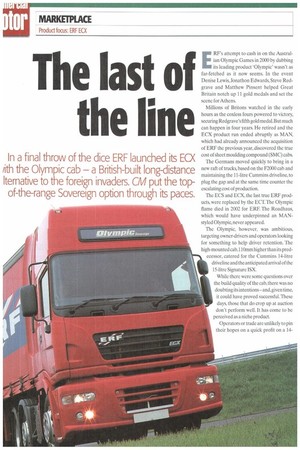The last of the line
Page 76

Page 77

If you've noticed an error in this article please click here to report it so we can fix it.
In a final throw of the dice ERF launched its ECX rith the Olympic cab — a British-built long-distance
lternative to the foreign invaders. CM put the top
of-the-range Sovereign option through its paces.
ERF's attempt to cash in on the Australian Olympic Games in 2000 by dubbing its leading product 'Olympic' wasn't as far-fetched as it now seems. In the event Denise Lewis, Jonathon Edwards, Steve Redgrave and Matthew Pinsent helped Great Britain notch up 11 gold medals and set the scene for Athens.
Millions of Britons watched in the early hours as the coxless fours powered to victory, securing Redgrave's fifth gold medal. But much can happen in four years. He retired and the ECX product run ended abruptly as MAN, which had already announced the acquisition of ERF the previous year, discovered the true cost of sheet moulding compound (SMC) cabs. The Germans moved quickly to bring in a new raft of trucks, based on the F2000 cab and maintaining the 11-litre Cummins driveline, to plug the gap and at the same time counter the escalating cost of production.
The ECS and ECX, the last true ERE products, were replaced by the ECT. The Olympic flame died in 2002 for ERF. The Roadhaus, which would have underpinned an MANstyled Olympic, never appeared.
The Olympic, however, was ambitious, targeting owner-drivers and operators looking for something to help driver retention. The high-mounted cab,110mm higher than its predecessor, catered for the Cummins 14-litre driveline and the anticipated arrival of the 15-litre Signature ISX.
While there were some questions over the build quality of the cab, there was no doubting its intentions— and,given time, it could have proved successful. These days, those that do crop up at auction don't perform well. It has come to be perceived as a niche product Operators or trade are unlikely to pin their hopes on a quick profit on a 14 litre tractor with a high cab when the competitiox offers such strong products. But the ERF EC 11.41 was warmly received by CM.
e Anglo-German collaboration had alr ady led to a long list of German-sourced cornponents appearing in the Middlewich-built ECX and ECS. Despite this they were still very muCh English trucks, with their home-built chassis using Ayrshire Metals' frame rails, trademark SMC cab and an outer SMC door skir bonded to an inner steel frame.
The axles were from MAN and they came witi the same air-operated Mentor D 'Elsa discs as the TGA, minus the TGA's electronic control. Even the Hendrickson-supplied midlift axle on the 6x2 tractor had the same MAN axle ends and identical calipers and discs. This en4ired commonality for servicing.
i4rnderneath the cab sat the Cummins ISM Cel ct straight-six, in Euro-2 guise. Our ECX's ISI started life as a 440 but a pre-test runaround our test route convinced ERF's engineers that a 405 rating would useless fuel so it was rechipped, losing 35hp prior to the test.
For the record, the ISM 405E produced an impressive 2,000Nm of torque, and behind the 10. -litre Cummins sits a Spicer twin-plate clutch with ceramic facings and an Eaton 16-speed S-Series synchromesh box. It was one of the last with the Eaton, which was soon replaced with the ZF's Ecosplit.
The top-of-the range Olympic Sovereign, the ultimate ECX trim package, cost an extra £8,750 but that included a TV, microwave, airconditioning, integral cooler/fridge underneath the sprung-mattress raised bunk, a pull-down wardrobe, dual-position raising table and a radio/CD player.
That said, the standard high-roof sleeper and plain Olympic trims weren't too basic, with heated windscreen, central locking, electric windows and mirrors.
We tested the ECX at 41 tonnes and in terms of payload it delivered the goods. With a tare of 8,120kg and a seven-tonne triaxle curtainsider, you're looking at a payload of 25,880kg.
The overall fuel figure of 7.79mpg with less than 7,000km on the clock made us take notice of its potential. For such a fresh engine to be so economical is unusual — and it returned over 9.6mpg through the A-road section.
The strength of the ECX/Cummins combination became evident during the'severe gradients' section of our route along the A68. It created a new record at 5.54mpg;our best figure at 40 and 41 tonnes at the time.
The lowdown If we've spent a disproportionate time discussing the ERF ECX Olympic Sovereign's interior, it's probably because all its other core values, includ ing outstanding ride and handling and keen pricing, can be taken as read.
Once again in a CM test, a Cummins-powered ERF proved itself to be light,fuel-efficient and productive. Come rain or shine (in our case, mostly rain), the ECX/ISM combination looked capable of earning its keep.
What we can't understand is why such a strong economic proposition didn't attract more owner-drivers. The truth is many buy on image; maybe the men from Middlewich failed to put enough thought into the ECX's interior to woo those demanding one-man bands. •






































































































































































































